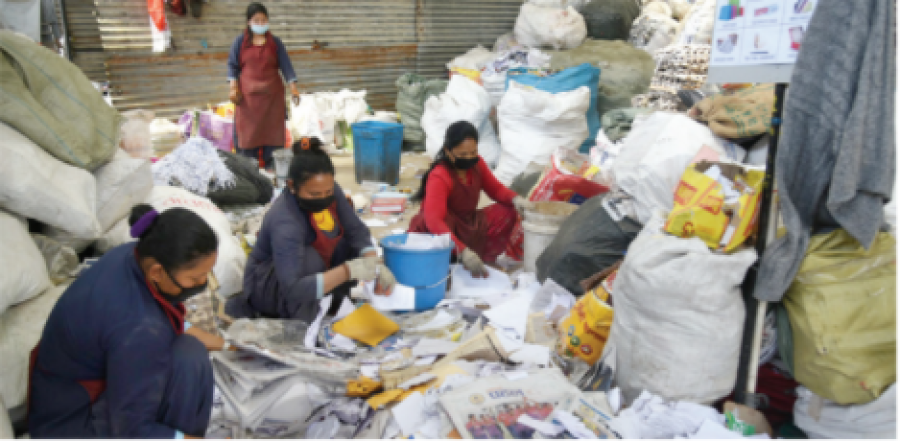National
Only half of municipal waste gets collected, far less recycled
The waste management baseline survey of Nepal was conducted by the Central Bureau of Statistics in the country’s 271 municipalities.
Chandan Kumar Mandal
In an indication of poor waste management in the country, a government report has shown that only half of the waste generated in the country’s municipalities are collected.
The Waste Management Baseline Survey of Nepal 2020, conducted by the Central Bureau of Statistics (CBS), found that a municipality on average collected 2,232.7 metric tonnes of garbage in 2019-20.
According to the survey, the annual average per municipality was 2231 metric tonnes in 2017/18 and 2164.4 metric tonnes in 2018/19, respectively. Based on the statistics, the average daily waste collection per municipality was 6.1 metric tonnes, 5.9 metric tonnes and 6.1 metric tonnes, respectively, for the last three years.
However, the waste collection status has not been encouraging in the country’s urban municipalities, according to Sushil Kumar Sharma, the director of the Environment Statistics Section of the Bureau.
“Through this baseline survey, we found that municipalities were not collecting enough waste,” Sharma told the Post. “Municipalities are not collecting all of their waste. They are collecting only around half the total waste.”
Of the total 293 municipalities of Nepal, the survey had covered 271 municipalities where waste had emanated from multiple sources like households, institutions, business/commercial complex, hospitals, among others.
The survey had categorized three types of waste generated in all these municipalities — organic waste, inorganic waste and other waste.
Organic waste included paper, textile, and agricultural waste. Inorganic waste comprised plastics, glass, rubber, metal and minerals, and other wastes consisted of waste that were not included in the previous two categories.
According to the survey’s findings, the proportion of organic waste in the garbage was higher compared to the other two categories. In the last fiscal year, organic waste comprised 54 percent of the garbage, inorganic waste 33.3 percent and other wastes 12.7 percent.
“The reason behind poor collection of garbage in municipalities is the lack of resources. Nearly 80 percent of municipalities did not have adequate infrastructure for proper waste management,” said Sharma. “Municipalities do not have the required capacity to collect all the waste generated in their territories.”
The survey also revealed that the waste collection work was handicapped due to lack of manpower in the municipalities. As per the findings, the overall average manpower available in the municipalities was 114 per municipality, with a higher number (477) in the metropolitan cities and lower (99) in municipalities.
Furthermore, the average number of manpower assigned for waste management was 118 per metropolitan city, 59 per sub-metropolitan city and 12 per municipality. Likewise, municipalities also lacked adequate technical manpower for waste management.
As a result, municipalities had their own methods of waste management like simply piling up the waste at landfill sites, dumping along the riversides, and open burning. The three main waste handling methods were piling up at landfill sites by 48.6 percent of municipalities, burning by 32.1 percent and piling up in the riverside by 27.4 percent, revealed the survey.
“During the survey, municipalities were found employing various methods of waste management. Some had landfill sites where they would dump the waste. Others said they were also dumping waste along the riverbanks,” said Sharma. “Some municipalities had adopted various methods including piling up the waste at landfill sites and riversides as well as burning a certain amount of waste.”
Sixty percent metropolitan cities and sub-metropolitan cities and 47.7 percent municipalities were piling up their waste at landfill sites. Of the total municipalities surveyed, 212 (78.2 percent) municipalities reported one or other methods of handling waste.
“While all the waste not being collected is another challenge, unsustainable ways of managing the waste brings more challenges. For example, burning waste, which should not happen, causes air pollution and affects human health,” said Sharma. “Similarly dumping of waste along the riverbanks or ditches causes water pollution and other impacts to the environment. And waste if dumped directly into the rivers or water bodies impacts the aquatic species and causes water pollution.”
Only 114 or 42.1 percent of the total municipalities surveyed were using landfill sites for waste management. Likewise, among the municipalities using the landfill sites, 85.1 percent reported having their own sites and 14.9 percent were using others’ landfill sites.
Only 12 municipalities or four percent—one metropolitan city, one sub-metropolitan city and ten municipalities—were using transfer stations for processing the solid waste before transferring it to landfill sites. Similarly, only five municipalities said they have adopted measures to prevent the foul smell of the transfer stations.
According to the survey, out of the total 97 landfill sites under consideration, only seven sites had one or other type of treatment system.
Another striking revelation the survey came up with was that only 30 (14.2 percent) municipalities, which included two metropolitan cities, five sub-metropolitan cities and 23 municipalities, were recycling their waste.
However, the recycled quantity of waste averaged a meagre 4.1 percent of the total waste produced.
“Although the municipalities were involved in recycling garbage, the quantity used for recycling was low and not all municipalities were engaged in recycling,” said Sharma, the director of the Bureau. “Only a few municipalities like Waling in Syangja have adopted the practice like ‘Waste to Energy’. Municipalities in the Kathmandu Valley have also started recycling the waste. However, the amount of waste recycled is negligible and the survey showed that recycling is not largely in practice.”




 16.77°C Kathmandu
16.77°C Kathmandu












.jpg&w=300&height=200)

